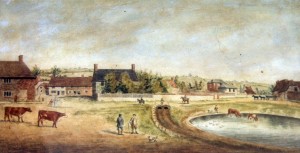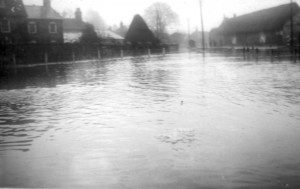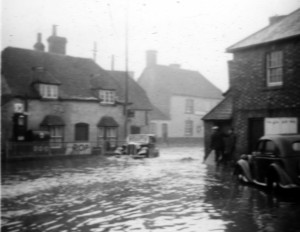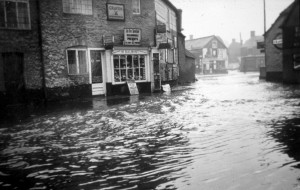

Aldbourne has occasional ‘flooding’ for two main reasons. First, it is situated at the confluence of several downland valleys none of which have a permanent water course. In periods of excessive rain, especially short intense rain storms, excess water is not absorbed quickly enough by the ground especially if it is already saturated or frozen. Instead the water rushes down the valleys into the village centre where it can overwhelm the drains and the brook. These floods quickly disperse. Second, the underlying chalk can only

store a certain amount of accumulated rain water. During long periods of wet weather and especially in late winter, the chalk reaches saturation, the

water ‘table’ rises and excess water ‘leaks’ out by way of various springs which can overwhelm drains and the brook. Once started the springs may flow for several months. Here are some examples from the last 200 years.
24 April 1811
A villager’s journal for that date records ‘…..came

on about 7 o’clock in the evening very terrible thunder and lightning and soon after a cloud burst….with wonderful hail for about an hour. The heaviest past of the storm came on…..across

Upper Upham, Snape Meadows, Lodge and Hillwood. A grand body of water entered West Street, Castle Street and down Butts and struck …against Mr Wells’s Bell Shop [near the Pond]about 5 feet high and much entered the house and garden. South Street was completely filled….up to a man’s knees. It entered The Malt House and covered the malt on the lower floors….and cottages below were nearly filled with

water and mud’.
January 1915
After a very wet autumn in 1914, the chalk downs

were saturated. Many springs appeared in the village and the overflowed the brook for many days. As can be seen the young lads in the village seemed well prepared with their stilts !
A similar situation caused the flooding in winter 2013/14.
4 February 1940

After many weeks of freezing weather with heavy snow, the ground was frozen. On 3 February heavy rain and a rapid thaw set in. The melted snow and rain could not be absorbed by the frozen ground and suddenly flooded the village. Local diarist

Muriel Foster wrote ‘ ….the water in Lottage Road was 5 feet deep and by morning people in Lottage were marooned in their bedrooms while furniture floated about downstairs. High Town was a lake which was unable to disperse and….so large holes were made in the wall and roaring torrents swept out. The West Street flood stretched half a mile to New Barn……. and [in South Street] the

roads and stream were indistinguishable…the bridges had inches of water over their tops’. Fortunately by the morning of 5th, it had mostly drained away.


